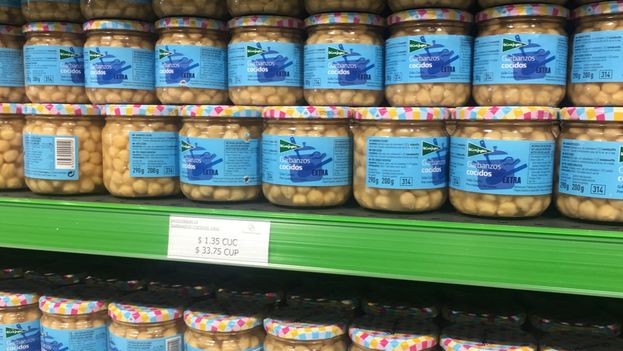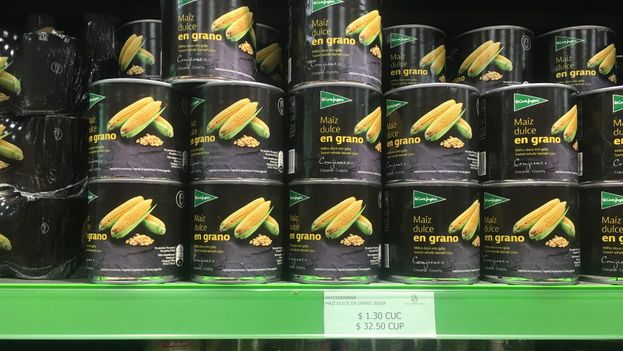
![]() 14ymedio, Marcelo Hernandez, Havana, 17 January 2018 — The corner of San Rafael and Galiano in Havana is now a plaza with a wifi zone where everyone stares at the screens of their mobile phones; but long ago the famous store El Encanto was built there, a business that inspired the creation of warehouses in Madrid called El Corte Inglés, which landed in Cuba this January, like a prodigal son, with some of its private label products.
14ymedio, Marcelo Hernandez, Havana, 17 January 2018 — The corner of San Rafael and Galiano in Havana is now a plaza with a wifi zone where everyone stares at the screens of their mobile phones; but long ago the famous store El Encanto was built there, a business that inspired the creation of warehouses in Madrid called El Corte Inglés, which landed in Cuba this January, like a prodigal son, with some of its private label products.
“Everything is very expensive and although they look good in comparison to the domestic products, these are products bought by foreigners or people who have a private business,” said Katia María, mother of two teenagers who was looking at the cans.
The containers fill the shelves in a scene that is barely remembered by the customers of the La Puntilla Mall west of the city. The economic problems, which have worsened in recent years, have made one of the best-stocked stores in the capital a site with almost empty shelves and poor quality products.
“These are things that I can do without and that I only buy once a year for a special occasion, but I could not do it frequently“
Now, with the arrival of the Spanish giant, there are cans of tuna, cans of the typical piquillo peppers, canned pasta and chickpeas. Customers walk up and down the aisles where the green triangle with cursive letters appears that announces the merchandise coming from the other side of the Atlantic. This Tuesday nobody put anything in a cart, they just looked, as if in a museum.
The effect has been seen immediately on market shelves. “We have had hard months because when there is toilet paper, there is no chicken or milk,” points out a customer of the shopping center who preferred anonymity. “I come to Miramar, although I live in Centro Habana, because this is an area of diplomats, so sometimes the stores are better stocked.”
The shopper was surprised to see the new product line but declined to buy anything. “These are things that I can do without and that I only buy once a year for a special occasion, but I could not do it frequently,” he says.
At the end of a shelf, an employee was still stacking some of the newly arrived products. “This is a type of merchandise that is usually slow-moving,” she says. “You can see that they are of good quality but not of first necessity and here people are looking for basically the most important ingredients to cook: oil, tomato sauce and canned meat or fish,” she says.
The prices do not help much either. “This can of tuna in sunflower oil costs more than what I get as a monthly pension,” says Irma Junco. However, this pensioner says she can allow herself a “taste” because she has just sold her apartment and moved to a smaller property and “the difference in money is for me to eat better, because I am bored eating rice with hot dogs and chicken.”
If in a market of El Corte Inglés in Spain a box of pasta Farfalle costs 1.46 euros, in Havana its price of 2.50 CUC is equivalent to 2.11 euros
The prices of the new products have also “swelled” quite a lot in their long journey from their origin. If in El Corte Inglés market in Spain a box of Farfalle pasta costs 1.46 euros, in Havana its price of 2.50 CUC is equivalent to 2.11 euros. Something similar happens with a 6-portion package of yeast powder, which has gone from 0.63 euros in Spain to 1.65 in Cuba.
The contrast becomes greater in those products that in Madrid are presented in packages and in Havana are sold by the unit. If a package of three cans of sweet corn costs Spaniards 2.09 euros, Cubans must pay 1.10 for each can. When the administration of La Puntilla is asked about this the answer is always: “We do not choose the prices, they are already determined,” in a clear reference to the management of the Hard Currency Collection Stores (TRD).
Cuban consumers have complained repeatedly about the lack of transparency with regards to the percentage of profit that the State takes on the products it sells in the TRDs. However, studies done independently put the amount at between 50% and 240% of the initial purchase cost in the international market.
As excessive regulations stifle the agricultural production of the island, the country must import more than 80% of the food that it consumes, which means an expense to the national coffers of more than 2 billion a year.
The canned corn, canned fruit, or ground coffee that are now marketed in La Puntilla are part of a huge bill that the island spends on the purchase of cereals, rice, beans, corn, soybeans, milk powder and chicken to sustain both the rationed market and the retail network.

In the last two years, with the economic crisis in Venezuela and the decline in oil shipments at a preferential price from that country, paying for this flow of imports has become very difficult. The lack of liquidity, in the face of the loss of profits from the resale of the oil, has caused Raúl Castro’s government to have to cut imports.
The name Aliada, another of the private labels of El Corte Inglés, is also printed on several packages of pasta that fill the shelves. Products of both private labels come to the island through the Italian company Farmavenda and are sold exclusively in the TRDs managed by the Revolutionary Armed Forces. So far only two stores in the Cuban capital offer their products, although there are plans to extend them to others this year.
Also arriving in Cuba in recent months, with less media hype, is another brand of food, this one marketed by Alcampo, the Spanish subsidiary of the French group Auchan.
The arrival of El Corte Inglés in Cuba via its imported food is an event charged with symbolism. The establishment was inspired by the sales techniques of the new El Encanto stores, founded on the island by the Spanish brothers José and Bernardo Solís.
The establishment was inspired by the sales techniques of the new El Encanto stores, founded on the island by the Spanish brothers José and Bernardo Solís
Two of their employees from Asturias, César Rodríguez and Ramón Areces, settled in Madrid after working for decades in the famous Havana store. There they founded, in 1935, the great department stores, to which they brought their experience in selling by departments, advertising campaigns and the design of the stained glass windows that had so much success among Cuban customers. To this day, the giant is still the most powerful in Spain despite its falling profits and its problems with the Treasury.
Its predecessor in Havana suffered a different fate. With the coming to power of Fidel Castro in January 1959, El Encanto was nationalized and in 1961 two firebombs burned it down. The Revolutionary government accused the CIA of being behind the action, in which the famous militia woman Fe del Valle died. The place where the property had been was turned into a park that now bears her name.
Despite its sudden end, El Encanto is still a recurring memory that comes up when talking about the island’s republican past.
“Now they are the ones who send products to us,” laments Irma Junco, a 78-year-old retiree who inspected the shelves of La Puntilla on Tuesday after learning about the arrival of the products from El Corte Inglés. “We were pioneers in a lot of things and now we are in the caboose of the train,” she says sarcastically, while holding a can of fruit cocktail with the logo of the Spanish brand.
___________________________
The 14ymedio team is committed to serious journalism that reflects the reality of deep Cuba. Thank you for joining us on this long road. We invite you to continue supporting us, but this time by becoming a member of 14ymedio. Together we can continue to transform journalism in Cuba.
